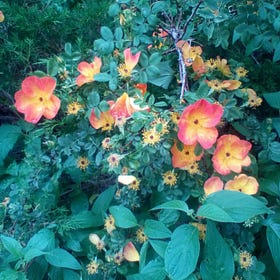Change How You Feel Through Improving Your Posture, Strength, and Flexibility
Where Movement Meets Meaning
*Crafted through thoughtful collaboration between Rosey and ChatGPT.
“The body is our unconscious mind.” – Dr. Joe Dispenza 🧠
We often think of emotions as purely psychological, and healing as a mental or spiritual game. But more often than not, it’s our bodies that give us the clearest signals. The way we stand, move, stretch, and breathe isn’t just physical—it reflects, shapes, and shifts how we feel.
If Part One of my book series was about the inner awakening—that whisper of “maybe there’s more”—this article is about how to live from that place. It’s about grounding transformation through embodied practice. This is where the spark becomes fire. 🔥
From Mind-Heavy to Body-Aware 🧠➡️🧘♀️
Let it be known: I was not a naturally athletic child. I enjoyed playgrounds, four square, tree climbing, and did a couple years of gymnastics and basketball—but I was always more at home in my head than in my body.
It wasn’t until middle school and high school theater, then acroyoga in college, that I started warming up to embodiment. But the real turning point came in 2018, after I tapered off the last of my psychiatric medications. 🎭
My psychiatrist told me that things like diet and exercise would become “even more important now.” And given how rough those first few months were, I took it to heart. I started running—first just trying to run a lap, then two, building slowly. My first goal was to run one uninterrupted mile. I reached it. And kept going. 🏃♀️
This was my first experience using movement as a conscious emotional resilience practice.
Metaphor in Motion 🌈
The next winter, my breathwork coach introduced me to the practice of doing 100 hip circles a day—50 in each direction. I don’t remember if she recommended it or if I copied her, but either way, it stuck. Somewhere along the line, I began associating emotional adaptability with hip flexibility.
I was also studying the Vital Body—chakras, meridians, and kouas—and beginning to feel the deeper links between the physical and energetic systems. This, combined with my growing appreciation for metaphor and the metaphysical, helped me intuitively map my body as a reflection of my mental and emotional state. 🌀
I think often of my mom’s persistent reminders to “hold your shoulders back.” At the time, she framed it as about appearances—but had she said, “Hold your shoulders back; it’ll help you feel more confident”? I might’ve listened. Turns out… she wasn’t wrong. 😅 Holding my shoulders back helps me feel more confident and improves my appearance.
Yoga was a game changer. Through consistent asana and pranayama practice, I came to know my body—and myself—on a level I didn’t know was possible. Books, massage therapy school, and a providing couple thousand hours of hands-on bodywork have certainly deepened that understanding. But nothing replaces direct experience.
A Call for More Somatic Therapies in Mainstream Counseling
Does this idea of an integrative approach to healing and growth float your boat? Check out this article from last fall, where I deep dive into the limitations of an overly heady counseling industry and call for somatic practices to come to the forefront.
Evidence I Can Feel ✨
In fact, the most obvious evidence that our bodies and emotions are connected has come through the simplest realizations:
🌿 The more physically flexible I become, the more mentally flexible I feel.
🪨 The stronger my body, the sturdier my emotional baseline.
💖 The more open my chest, the more generous and courageous I feel.
🎠 The more mobility and looseness in my hips, the more playful and worthy I feel.
Now, whenever I’m experiencing any kind of imbalance—tightness, unusual sensation, even food cravings—I ask myself: What’s the metaphor here?
Feeling cold? Too much yin. ❄️
Feeling overheated? Too much yang. 🔥
Craving spice? I want more excitement. 🌶️
Craving sweets? I want more delight. 🍭
Headaches? Too much mental energy—time to ground or dance it out. 🧠🩰
I’ve also learned to observe emotional patterns in others through their posture and movement—but I’ve curbed the habit in daily life. 😆 Still, many of us share postural and muscular habits shaped by the emotional norms of our culture.
Sensation as Signal 💃
Stretching, yoga, breathwork, and running have all triggered emotional releases in me. And here’s a quirky one for you: lately, as I practice splits at Club Fitness, I’ve been feeling a lot of arousal in my vulva. 😂 Once I get past the awkwardness, it’s oddly motivating. Apparently, my body loves flexibility!
If this all sounds weird but you’re even a little open-minded, my invitation is simple: observe your own body. Be curious. Try something physical and see how your emotional state shifts.
Engage consciously. Combine the physical and the psychological. And yes, while your inner materialist might scoff and say “correlation isn’t causation,” I’d counter with: if it helps you feel better, does it matter? 🤨
We can always refine our understanding. But first, we have to actually have the experience.
Losing (& Discovering) HEALTH Early in Life
"Health is like money, we never have a true idea of its value until we lose it.”
Would you like some bonus inspiration? Here are my reflections on how healing through chronic illness early in life helped me shine my light, and the belief that you can do the same.
Practical Tools: Try This for Yourself 🧘♀️🛠️
Here are a few ways you can begin integrating posture, strength, and flexibility into your emotional regulation practice:
1️⃣ Hip Circles (100 a day – 50 in each direction): Excellent for increasing hip mobility and emotional adaptability. Try them slow and smooth, then switch directions. Notice how it feels—not just physically, but emotionally.
2️⃣ Posture Checks: Once a day, pause and ask, Where are my shoulders? How is my spine stacked? Take one minute to realign with intention. Bonus points if you repeat a supportive affirmation like: “I am confident and grounded.”
3️⃣ Chest-Opening Poses (like Cobra, Bridge, or Fish Pose): Open your heart, literally. Do these daily for 2–5 minutes. Observe if your capacity for connection and generosity increases. 🧘♂️💓
4️⃣ Splits Practice or Long-Held Stretches: Choose one stretch to commit to for a week. Hold it for 60–90 seconds and breathe into the sensation. Feel what emotions arise. No need to analyze, just notice.
5️⃣ Movement + Reflection Combo: Go for a 10-minute walk with the question “What is my body trying to show me today?” and write down whatever comes to you afterward. 📝🚶♀️
6️⃣ Observe Your Cravings: Next time you crave something specific, ask what your body/emotions might be trying to signal. Then do something loving in response. 🍫💌
Where This Leaves Us 🌿💫
Let your body be your teacher. Let your movements be prayers. Let your stretches be stories. 📖🧎♀️
If your emotions feel too loud, or your mind too full—start with your breath. Start with your spine. Start with your hips. 🌀
You’re not just a brain with a body—you’re an entire ecosystem. Treat yourself like one.
This is where healing gets real. This is where change begins to root.
Next week, we'll continue The Twelve Books That Changed My Life series with Part Two- Fuel for the Awakened Body. Stay tuned for literary works that will support your embodiment, emotional depth, and somatic awareness.
With grounded strength and curiosity,
🕯️ Rose




